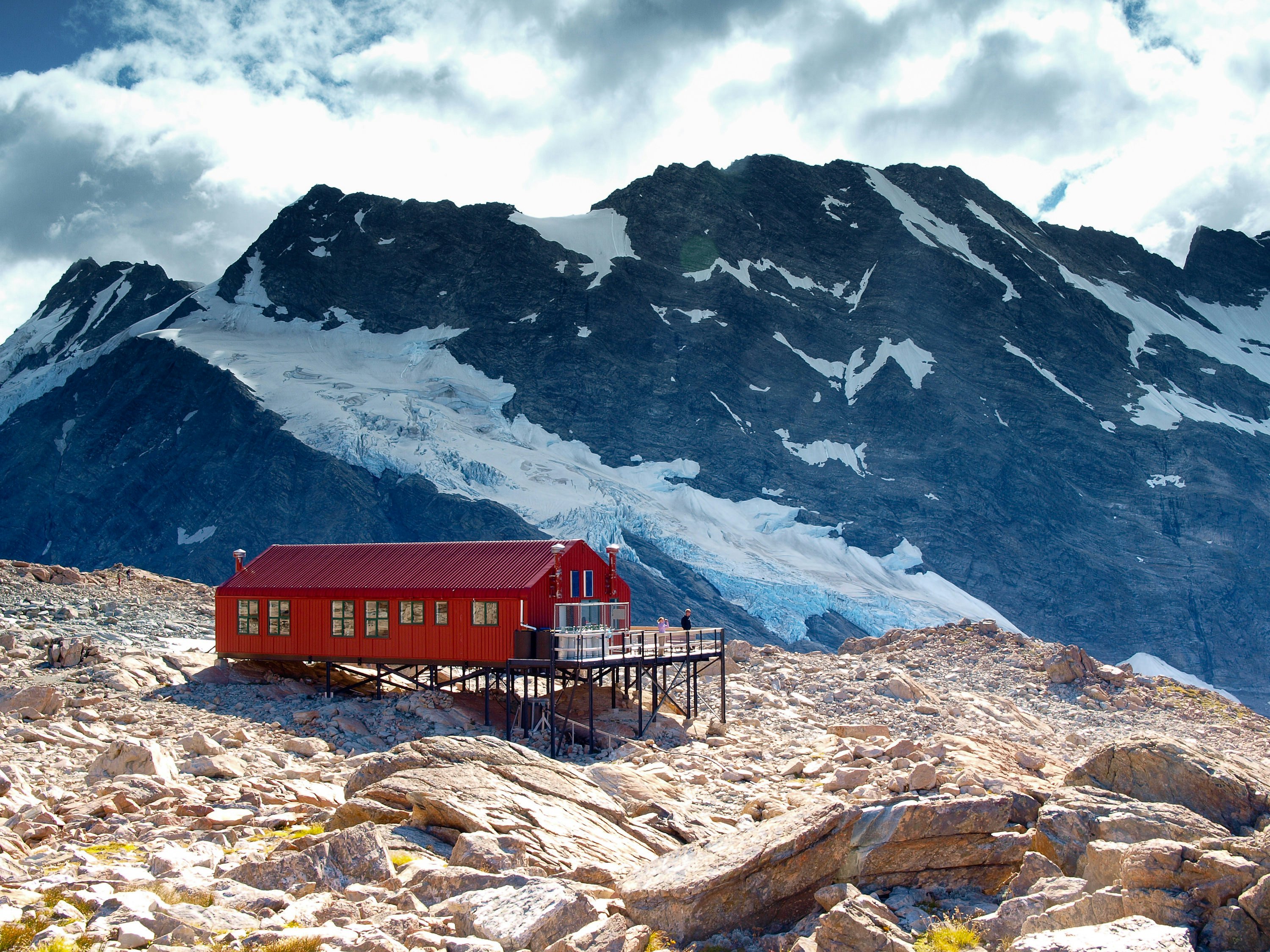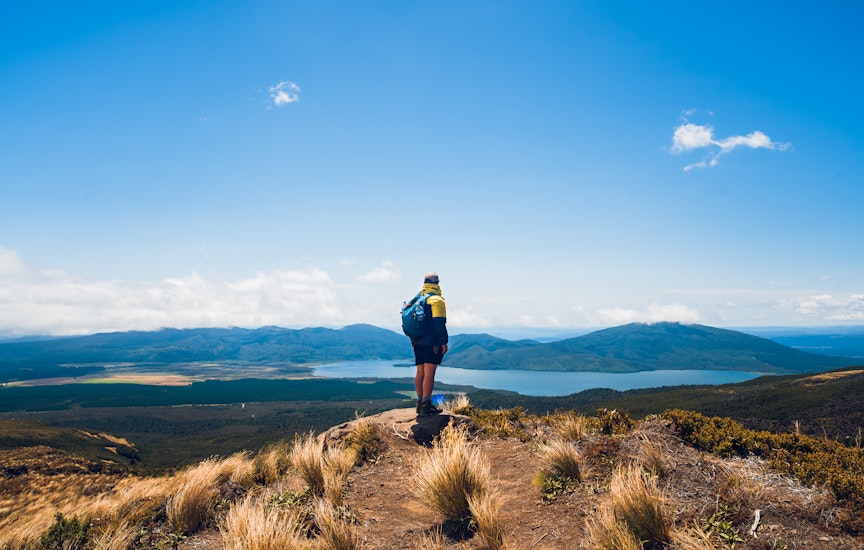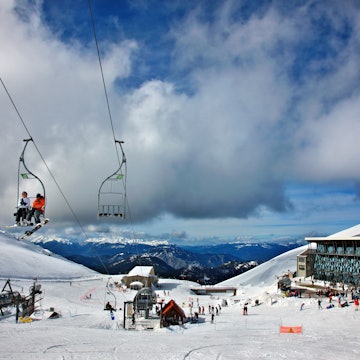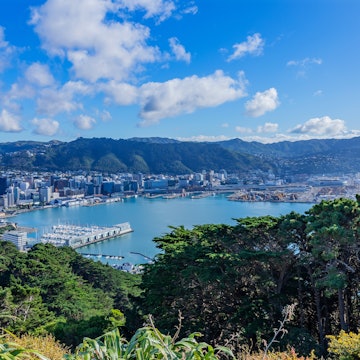

Mt Brown Hut in Lake Kaniere Scenic Reserve, New Zealand's West Coast. NicksPlace/Getty Images
There’s something magical about stumbling upon a backcountry hut after hours of trudging through mud, over roots, and up never-ending switchbacks. At its core, a hut is a shelter – a roof over your head, a refuge from the storm, a place to rest tired legs. But in New Zealand, backcountry huts are more than just practical – they’re an iconic part of the country’s rugged outdoors, offering access to some of the most breathtaking landscapes on the planet.
With around 1500 huts scattered across the country, New Zealand boasts one of the most extensive and accessible backcountry hut systems in the world. Nearly 1000 of these huts are managed by the Department of Conservation (DOC), meaning they’re open to the public. Some are free and others for a fee; a rarity, as backcountry shelters in other countries often require club memberships or hefty fees. Some huts sit high in the alpine, while others are nestled in lush native bush, or just a short stroll from the parking lot, making them perfect for families and casual hikers.
The huts officially became a part of New Zealand’s history in 1987, when DOC was established and took charge of the hut and track network across Aotearoa. Since then, many contemporary huts have been added to the system along popular tracks. However, many are historic outposts from another era: tucked into the Southern Alps or perched precariously along coastlines, they provided shelter for musterers and refuge from harsh storms.
For visitors to New Zealand, the huts make it possible to experience the country’s stunning landscapes without the hassle of carrying bulky camping gear. With huts providing shelter, mattresses, water, and often heat sources – and in some cases, cooking facilities – you can enjoy the wilderness with a lighter pack and greater ease.
Whether you’re a seasoned “tramper” (hiker) or just dipping your toes into New Zealand’s backcountry, spending a night in a hut is an experience not to be missed.

What can I expect to find in a hut?
Huts range from super rustic to backcountry luxury, depending on the hut type. Great Walk Huts are the most plush (and expensive), with an on-site hut warden during the Great Walks season, making them a great option for first-time trampers. Serviced huts are the next step down. Standard huts are more rustic than a serviced hut but have amenities that make them a sight for sore legs. A basic hut or bivy provides shelter only, often quite small and only offering four walls and a roof, sometimes a heat source. On the plus side, they’re typically free.
Regardless of the hut type, they all have a few things in common: they’re communal, meaning you’ll sleep in a bunkroom, sometimes shoulder to shoulder with other trampers, on plastic-wrapped mattresses. Toilets are typically long drop or composting outhouses, detached from the main house – great for preventing smells but bad for middle-of-the-night trips. Water is either from a rainwater collection tank or a nearby stream, which means you should boil before using.
These huts are also in beautiful, often remote locations, where you may hear kiwi birds call out in the night or watch a tūī as you sip your morning coffee. The connection among trampers is special – a feeling of camaraderie when you’re miles from civilization and even further from home. I can assure you that any reservations you have about "roughing it" will diminish on your first night.

What do I need to bring to a hut?
First, check the hut’s description page on the DOC site for amenities. The icons on a hut page will denote amenities available, such as an electric heat source or wood burner, mattress, lighting and water source. Pack space is precious so this can help you determine what you need to bring.
There are some things you should always pack: your food, a sleeping bag, crockery, suitable clothing for the hike including wet weather gear and proper footwear, a headlamp and powerbank if you rely on your phone to take pictures or consult downloaded maps. While some huts do have solar-powered lighting and a few have USB charging outlets, it’s still best to come prepared as there’ll likely be a line to charge your device. There aren’t any huts with power outlets. While serviced huts typically have toilet paper, I always prefer to bring a half-roll, just in case.
Anything else is based on comfort. Some people bring blow-up pillows, eye masks and earplugs to make sleep more comfortable – that definitely helps if you're bunking with someone who snores! Many seasoned trampers bring hut clothes to change into: a cozy sweater, sweatpants or thick socks, as shoes aren’t allowed in huts. For entertainment, it’s hard to go past a classic deck of cards or a book if you can spare the space.
If you need to hire gear, check out Auckland’s Living Simply, Christchurch’s Bivouac, or Queenstown’s Small Planet Sports or Outside Sports.

How to book a New Zealand backcountry hut
Bookable huts allow you to secure a guaranteed spot for the night, while first-come, first-served huts don’t, so for those it’s best to arrive early and bring a tent as backup. Each hut’s information page will indicate whether it requires booking. Reservations and payments can be made through DOC’s online system for bookable huts. It’s recommended to print or screenshot your booking as proof.
Hut prices vary greatly and are listed on each hut’s webpage. Some have seasonal pricing and Great Walk huts charge different rates for international visitors, so check the details before your trip.
A guide to standardized hut pricing:
Serviced huts are $25 (US$14.70) per adult per night, though some huts have unique pricing and some vary depending on the day of the week you’ll stay
Standard huts are $10 (US$5.90) per adult per night, with some huts observing unique pricing
Basic huts and bivvies are always free.
A Backcountry Hut Pass is a cost-effective option if you plan to visit multiple huts a year. For $160 (US$94) per adult, it provides unlimited access to most Serviced and Standard huts, and most campsites near Serviced huts. Though some exclusions apply, the pass can be used for bookable and non-bookable huts. The pass does not guarantee a bunk in first-come, first-served huts.

What are New Zealand’s most popular huts?
New Zealand’s hut system offers everything from iconic alpine shelters to family-friendly spots with great views. Dotted across the varied landscape gives each hut its own charm, inviting first-timers and seasoned regulars to a memorable night away. Here's a pick of our favorites.
Mueller Hut
New Zealand's most iconic hut
The Mueller Hut is iconic. The famed red shelter nestles into the Southern Alps in Aoraki/Mt Cook National Park, a timeless beacon for alpine explorers. The four-hour track features a challenging 1000m (3281ft) ascent, but the climb rewards you with views of Aoraki, the Hooker Valley, and surrounding glaciers, with beautiful sunrises. That's well worth the effort.
Pinnacles Hut
A North Island gem
The Coromandel’s Pinnacles Hut is a great way to experience the beauty of the North Island. The track winds through ancient kauri (a type of endemic tree) logging trails, swing bridges and lush native bush before reaching the 80-bunk hut. Staying overnight allows you to make the sunrise climb to Pinnacles summit, rewarding you with 360-degree views of the Coromandel ranges, coastline and distant peaks.
Almer Hut
A piece of history
While the current Almer Hut was upgraded in 1992, the original structure was air-dropped onto the site in 1950. The serviced alpine hut sits above Franz Josef Glacier and provides the perfect backdrop to your morning cup of coffee.

Packhorse
Best hut for families
The Banks Peninsula’s Packhorse Hut is a great walk that introduces kids to hiking and staying in huts. The relatively short walk (DOC estimates 1–3 hours) on a well-graded track is perfect for little legs. The historic hut is built from local volcanic stone and offers sweeping views of Lyttelton Harbour and the Port Hills.
Nydia Lodge
Best wheelchair-accessible hut
For a secluded, backcountry-like experience that provides wheelchair accessibility (with assistance), book Nydia Lodge in Pelorus Sound. Accessible only by boat (water taxi services such as Kenepuru Water Taxi offer wheelchair-accessible transport), the lodge sleeps up to 50 people and can be rented out for $494 (US$290) a night – a bargain considering the beautiful surroundings.
Tips for hut etiquette
Huts are small and you'll be sharing the kitchen, sleeping and communal spaces, so being kind, friendly and accommodating is important. Be considerate of others during meals and when they're trying to sleep, don't dry your wet clothes on picnic tables, or stay up all night partying. If you plan to leave early the following day, pack up your bag at night so as not to disturb any sleeping trampers.
Shelter is a hut's primary purpose, so welcome trampers in rough weather conditions, even when the hut is full. There's always space to sleep on the floor when conditions are dire.
If there’s a fire available at your hut, practice fire safety and gather more firewood if it's available. Finally, leave all wet, muddy gear outside. That means all shoes, no exceptions.
To make cleanup super easy, here are a few standard rules:
Prop your mattresses against the wall to let it air out
Pack all garbage out (there is no place for trash at the huts)
Sweep before you leave
Restack firewood if any was used
Fill out the visitor logbook
Latch doors and windows when leaving.

Can you get a similar backcountry experience without staying in a hut?
Absolutely. If you want to stay in a DOC-managed location but prefer to drive to the accommodation or want more amenities, you can book a DOC lodge, cabin or cottage. Still more rustic than a hotel, they give you access to DOC’s beautiful locations, either a short walk, boat or drive away from civilisation, with stays starting from $28/night (US$16.40).
Dialling into the secluded charm of New Zealand’s hut system but turning up the luxury, Canopy Camping offers a range of unique stays across the country. Nestled into secluded nooks on private properties, some are renovated old huts, glamping tents or rustic cabins, all providing stunning views, relaxing amenities and a genuine chance to unplug. Some of my favorites include a renovated boat sitting on dry land just a short drive from the Waipara wine region outside of Wellington, an off-grid cabin overlooking the Kaikōura coastline, or a cliffside tree tent on Karioitahi Beach an hour from Auckland. No bunks in sight.
For more information about New Zealand’s hut system, visit DOC’s website.












![Manukau Heads Lighthouse, Auckland, New Zealand [closeup view] License Type: media Download Time: 2022-02-25T15:39:58.000Z User: bhealy950 Is Editorial: No purchase_order:](https://lp-cms-production.imgix.net/2025-10/Shutterstock1352692988.jpg?auto=format,compress&q=72&fit=crop&w=360&ar=1:1)


